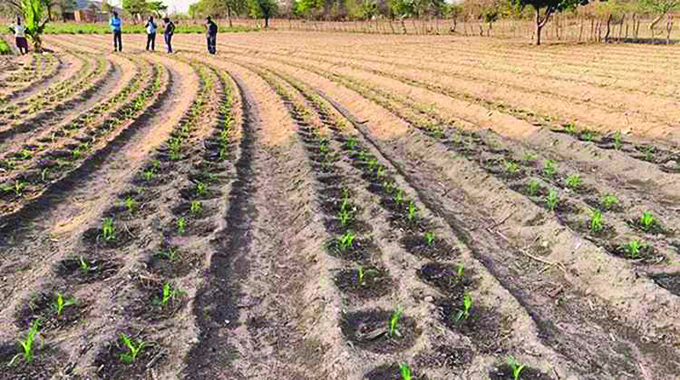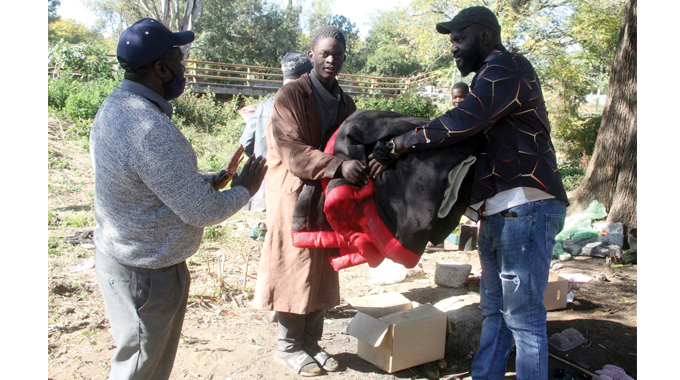Super mum is raising 10 children…Hard work in the cotton fields pays

Mashudu Netsianda, Senior Reporter
OVER the years, Ms Senzeni Sibanda (44) from the Dundubala area of Umguza District in Matabeleland North Province has been struggling with the responsibility of raising her 10 children.
Hard labour characterises her busy lifestyle, as she is always engaged in endless chores and long working hours in the field, where she mainly grows cotton.
A lot of effort is needed for her to complete each day’s tasks and achieve her set goals.
Ms Sibanda has managed to overcome the entrenched stereotypes towards gender roles in the home and in the field of work.

Ms Senzeni Sibanda harvests cotton from her field in the Dundubala area, Umguza district
Often women have little opportunity to influence farming practices or business decisions. But not so with Ms Sibanda, who has distinguished herself as one of the few farming champions as she grows healthy crops and produces some of the best possible yields to sustain her family.
In particular, she has found satisfaction in growing cotton, which for the past 10 years has provided sustenance for her family. Out of her 10 children, two of them are at university thanks to proceeds from farm labour.
Despite the prolonged dry spell that affected most farmers across the country, Ms Sibanda has managed to record a moderately good harvest under the Government-sponsored Intwasa/Pfumvudza programme, which she is expecting to deliver to the Cotton Company of Zimbabwe (Cottco).
When Government introduced Intwasa in March 2020, the aim was to maximise productivity per unit area, even during drought periods, to ensure household and national food and nutritional security.

Intwasa involves the utilisation of small pieces of land and applying the correct agronomic practices for higher returns. The approach can be used in marginal areas and still give high yields.
Through her vast farming experience, Ms Sibanda, who was not keen to discuss her marital status and only revealed that her husband is based in Chinhoyi, said she has learnt how cotton relies a lot on the weather, including how little “things” can be tweaked year after year to produce the best crop possible.
A Chronicle news crew visited Ms Sibanda’s plot in Dundubala to share her Intwasa success story in cotton farming.
From the deep green plant and its blooming flowers, Ms Sibanda’s field resembled snow in the fall.
“I earn a living through growing cotton and I have managed to raise my 10 children through cotton. Two of my children, both girls, are studying at Midlands State University while the other one has just completed A-level and will soon be joining the Airforce of Zimbabwe,” she said.
“Unfortunately, my son didn’t manage to write final O-level examinations after developing an eye-related ailment.
“My other six children are attending school at Dundubala Primary and I have been paying school fees using proceeds from cotton farming.”

Pfumvudza Intwasa fields
The cotton marketing season for 2022 began on Monday with the Government setting the new prices for the commodity, which will see farmers getting US dollar part payment of 30 US cents per kilogramme in addition to the Zimbabwe dollar component of $32 per kg.
Before the upward review, the Government had set the pre-producer price for 2022 at $111 per kilogramme for the crop funded by private companies and $63,23 for cotton produced under State-assisted farming programmes — Pfumvudza/Intwasa and the Presidential Free Inputs Scheme — and an additional US$30 per bale.
Ms Sibanda said due to drought, this season she will deliver less than four bales of cotton to Cottco.
“As a smallholder farmer, I rely on cotton for a living. I planted cotton through Intwasa and was anticipating to get at least four bales from my small plot, but sadly this year, we had a challenge of drought,” she said.
The cotton crop suffered two major setbacks — the late onset of the rainy season and a very long dry spell experienced in most cotton-growing regions during mid-season.

However, unusually heavy rains in March through April added more damage to what had been caused by the mid-season dry spell. Initially, the cotton industry had projected that production would drop to 92 000 tons.
According to the latest figures from Agritex, the country’s cotton output is expected to decline by 30 percent this year to 116 000 tons, which is higher than initial estimates after late rains salvaged some of the crop.
“However, I am optimistic that with what I managed to harvest, I will be able to feed my children and pay their school fees,” said Ms Sibanda.
Through farming cotton, Ms Sibanda managed to buy four goats and they have been multiplying over a period of time.
“I want to make a difference in my community and encourage more girls and women to venture into cotton farming as a source of income,” said Ms Sibanda.
Climate change impacts crops and reduces yield leading to a reduction in income. Much of the growing season depends on the weather and a commitment to innovation and adaptability. Cotton is an important raw material for the country’s textile industry.
Zimbabwe’s cotton season runs in two phases: planting between October and January and a harvesting and marketing phase that normally runs from May to September.
To ensure an orderly marketing season, Government is set to introduce a law that severely punishes cotton contractors and farmers engaging in side marketing and any other activities that breach regulations governing the sector.
Failure to comply attracts hefty fines like de-registration or suspension. The new regulations also penalise contractors who fail to provide minimum inputs per hectare, operate outside designated common buying points or conduct mobile buying, use defective weighing scales, growing and marketing of a ratoon crop, among others.
Apart from providing sustenance to many households, cotton is one of Zimbabwe’s key foreign currency earners, especially in terms of net inflows and comes only second after tobacco; in terms of agricultural exports.–@mashnets










Comments